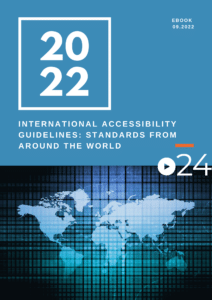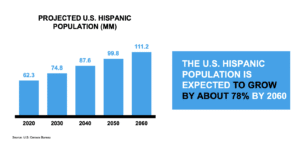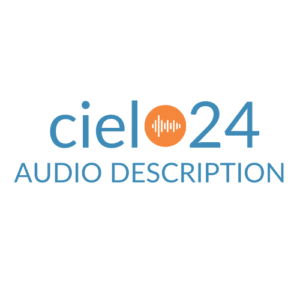What are the Legal Requirements for Captioning Spanish Video? The Federal Communications Commission, or FCC,…

Unlocking New Markets: Video Localization for Spanish-Speaking Audiences
As the world continues to become more connected and diverse, it is becoming increasingly important for businesses to cater to a wider audience. One way to do this is by providing video transcripts in different languages, particularly in Spanish. There are 41 million native Spanish speakers in the United States alone and a growing number of Spanish-speaking households and buying power across the globe. Providing translated transcripts can help spanish-speaking audiences

The importance of reaching Spanish-speaking audiences cannot be overstated, especially in the United States where there are over 62 million Hispanic or Latino residents, making up approximately 19% of the total population. This number is projected to reach 119 million by 2060, according to the U.S. Census Bureau. Additionally, Spanish is the second most commonly spoken language in the world, with over 580 million speakers globally. With such a large and growing demographic, it’s crucial for businesses and organizations around the globe to reach this audience by providing translated video transcripts in Spanish.
Firstly, let’s look at the statistics for Spanish-speaking viewership in the United States. According to a report by Nielsen, Spanish-language television networks reached 9 out of 10 Hispanic adults in the United States in 2020. This is a staggering number, and it shows the impact that Spanish-language content can have on this demographic. Additionally, the report showed that Spanish-language programming has increased its share of total television viewing among Hispanic audiences over the past few years.

According to a report by the Pew Research Center, Spanish is the second most common language spoken in the United States, with over 41 million native speakers. And the way the data is trending, by 2050, one in three people in the U.S. will speak Spanish (this data includes bilingual people who also speak English). This means that by providing video transcripts in Spanish, businesses can tap into a huge potential audience that may have been previously untapped.
In fact, according to a recent study by the Common Sense Advisory, 72.1% of consumers spend most or all of their time on websites in their own language, and 56.2% of consumers say that the ability to obtain information in their own language is more important than price. This highlights the importance of catering to different language speakers, particularly in a diverse country like the United States.
This means that providing translated video transcripts in Spanish can help businesses and organizations can localize their content to reach a large number of households that may not be reached otherwise.
The Case for Video Localization
- 72.1% of consumers spend most or all of their time on websites in their own language.
- 72.4% of consumers said they would be more likely to buy a product with information in their own language.
- 56.2% of consumers said that the ability to obtain information in their own language is more important than price.
Another factor to consider is the buying power of Spanish-speaking consumers. According to a report by the Selig Center for Economic Growth, Hispanic buying power in the United States is projected to reach $1.9 trillion by the end of 2023. This represents a significant increase from the $1.5 trillion in Hispanic buying power in 2018. This means that businesses and organizations that cater to Spanish-speaking audiences have the potential to tap into a lucrative market.
More than half of consumers are willing to pay more if you are willing to give them information in their own languages.
But it’s not just in the United States where Spanish-speaking audiences are important. Spanish is the second most commonly spoken language in the world, with over 559 million speakers globally. According to a report by Common Sense Advisory, 72.4% of consumers spend most or all of their time on websites in their own language. This means that businesses and organizations that provide translated video transcripts in Spanish can reach a global audience and increase their chances of engaging with potential customers.
Spanish is spoken by more than 559 million people globally. Of those, 460 million are native speakers, making Spanish the language with the second-largest population of native speakers in the world
It’s also worth noting that providing translated video transcripts in Spanish can improve accessibility for Spanish-speaking audiences. In the United States, Spanish is the primary language for many individuals and families, and not providing Spanish-language content can limit their access to important information. Additionally, providing Spanish-language content can help bridge the digital divide for Spanish-speaking communities who may not have access to high-speed internet or other technologies that make it easy to access information.
Translating video transcripts in Spanish can also help improve search engine optimization (SEO) for businesses and organizations. According to a report by Google, 60% of consumers start their search for products and services with a search engine. This means that businesses and organizations that provide translated video transcripts in Spanish can have higher rates of discovery and more presence on search engines.
Spanish-Speaking Audiences Conclusion
Spanish video transcripts can significantly benefit an organization’s media accessibility, expand reach to millions of Spanish-speaking people, and improve content SEO rankings and performance. It’s proven in the data.
It’s clear that there is a wealth of opportunities for organizations to reach these audiences. Yet, many opt to save a few dollars at the expense of losing these potential customers. The question must be asked: is short-term budget flexibility worth losing out on millions of potential customers? If your answer is “No,” then, investing in transcript translation services can pay considerable dividends in your organization’s future.
cielo24 provides robust accessibility video localization solutions

 Contact cielo24 for additional information about Video localization services, contact us here.
Contact cielo24 for additional information about Video localization services, contact us here.
According to a survey by Verizon Media, 80% of consumers are more likely to watch an entire video when captions are available. Enjoy a complimentary trial account.
International organizations enjoy local hosting, a wide range of foreign languages, and other services, learn more.
Looking for Audio Description? Get started with WCAG 2.1 AA compliant Audio Description product.
cielo24’s new Audio Description solution brings an improved video experience to people with low vision, vision impairment, and blindness. Give it a try now >>



